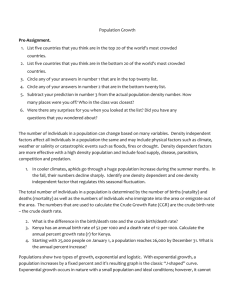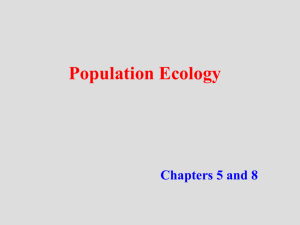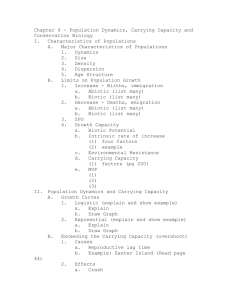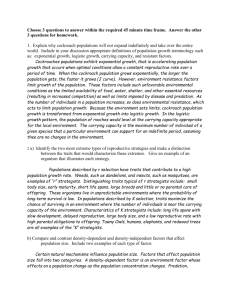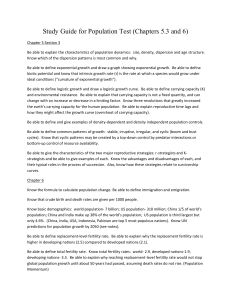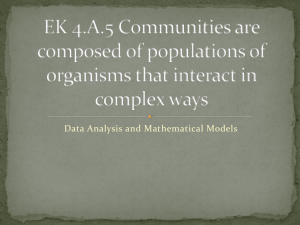Population ecology
advertisement
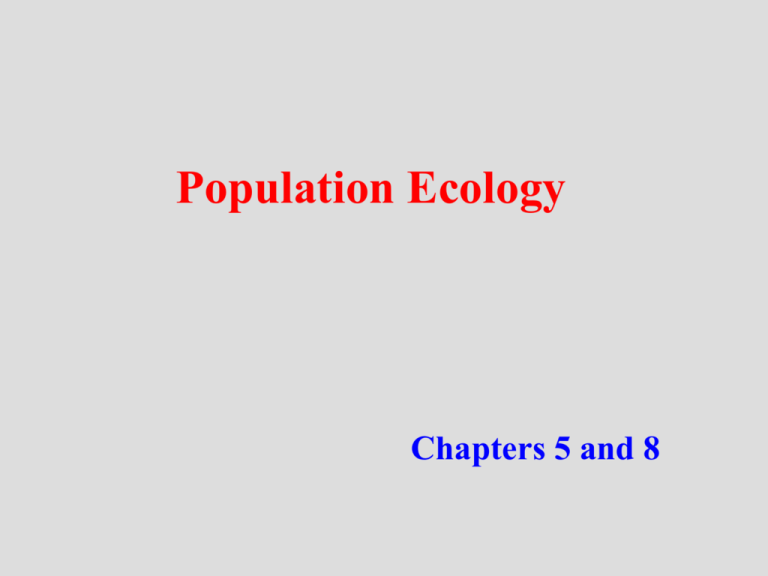
Population Ecology Chapters 5 and 8 • Ecology is studied at several levels Ecology and evolution are tightly intertwined • Biosphere = the total living things on Earth and the areas they inhabit • Ecosystem = communities and the nonliving material and forces they interact with • Community = interacting species that live in the same area Levels of ecological organization • Population ecology = investigates the quantitative dynamics of how individuals within a species interact • Community ecology = focuses on interactions among species • Ecosystem ecology = studies living and nonliving components of systems to reveal patterns – Nutrient and energy flows Some Definitions Population Ecology – The study of biological factors that affect the sizes of population Demography – The study of human populations in numerical terms Population – A set of potentially interbreeding individuals in a certain geographical location at a certain time Some Definitions Census – a head count of all the individuals living in a specified area. Growth rate – The rate of change of population size -birth rate – number of births per year divided by number of people in the population -death rate - number of deaths per year divided by number of people in the population Population Ecology • • • • Population- how to measure? Growth rates: J shaped, S shaped K, r, and reproductive strategies Human population How are populations measured? • Population density = number of individuals in a given area or volume • count all the individuals in a population • estimate by sampling • mark-recapture method depends on likelihood of recapturing the same individual Figure 35.2A The dispersion pattern of a population refers to the way individuals are spaced in their area (a) Clumped (elephants) (b) Uniform (creosote bush) (c) Random (dandelions) Mathematics of population growth •Births per year = bN (where b = per capita birth rate, N = Population Size) •Deaths per year = dN (where d = per capita death rate , N = Population Size) •dN/dt = bN - dN = (b-d) N = r N (where r = b-d, dN/dt = Change per year) •r is called Biotic Potential or intrinsic rate of natural increase. If immigration and emigration also occur then r = (b + i) – (d + m) •dN/dt = rN Nt = Noert Nt = Population at time “t” No= Initial population (at time “0”) e = Euler’s Constant r = Biotic Potential t = Time Figure 35.3A high intrinsic rate of increase 1500 Population size 1000 low intrinsic rate of increase 500 r=0 zero population growth negative intrinsic rate of increase r = -0.05 0 0 5 10 Time (years) 15 20 A street scene in Quito, Ecuador Graph showing the growth of world’s human population MALTHUS' VIEW ON POPULATION (1798) A population tends to increase geometrically if its growth is unchecked The available food supply increase only arithmetically Since the population increases faster than the food supply, the increasing population causes human misery and poverty MALTHUS' VIEW ON POPULATION (1798) A new population shows rapid exponential growth at first Its growth rate levels off when it approaches the carrying capacity of its environment, a phenomenon called logistic growth Malthus’ View On Population Exponential Growth Compared With Logistic Growth. The Steeper (more vertical) The Slope, the More Rapid The Rate Of Growth Limiting factors restrain growth • declining birth rate or increasing death rate • Limiting factors = physical, chemical and biological characteristics that restrain population growth – Water, space, food, predators, wastes and disease • Environmental resistance = All limiting factors taken together Figure 9-4 Page 166 Environmental resistance Population size (N) Carrying capacity (K) Biotic potential Exponential growth Time (t) POPULATION SIZE Growth factors (biotic potential) Abiotic Favorable light Favorable temperature Favorable chemical environment (optimal level of critical nutrients) Biotic High reproductive rate Generalized niche Adequate food supply Suitable habitat Ability to compete for resources Ability to hide from or defend against predators Ability to resist diseases and parasites Ability to migrate and live in other habitats Ability to adapt to environmental change © 2004 Brooks/Cole – Thomson Learning Decrease factors (environmental resistance) Abiotic Too much or too little light Temperature too high or too low Unfavorable chemical environment (too much or too little of critical nutrients) Biotic Low reproductive rate Specialized niche Inadequate food supply Unsuitable or destroyed habitat Too many competitors Insufficient ability to hide from or defend against predators Inability to resist diseases and parasites Inability to migrate and live in other habitats Inability to adapt to environmental change 2. Logistic growth is slowed by density dependent limiting factors K = Carrying capacity is the maximum population size that an environment can support Figure 35.3B Logistic Growth Equation • logistic growth curve – K = carrying capacity – The term (1-N/K) accounts for the leveling off of the curve Figure 35.3C How does population density affect population growth? • Density-Independent Factors – Affect a population’s size regardless of its population density – Floods, hurricanes, drought, weather, fire, habitat destruction, and pesticide spraying • Density-Dependent Factors – As density of population increases, these factors have a greater effect • Competition, predation, parasitism, and disease • Bubonic plague—urban hell batman… Exceeding K • Some species do not make a smooth transition from exponential and logistic growth – Instead temporarily overshoots K because of reproductive time lag (the period needed for birth rate to fall and death rate to rise in response to resource overconsumption) – Dieback or population crash • Reindeer introduced onto island • Technological, social, and other cultural changes have extended earth’s K for humans 2.0 Overshoot Number of sheep (millions) Carrying capacity 1.5 1.0 .5 1800 1825 1850 1875 Year 1900 1925 Population overshoots carrying capacity Number of reindeer 2,000 Population crashes 1,500 1,000 500 Carrying capacity 1910 1920 1930 Year 1940 1950 Taking Age into Account • The best answer is simple, but no simpler Albert Einstein • Seek simplicity, then distrust it Lord Alfred North Whitehead • The Exponential and Logistic Models Make Some Simplifying Assumptions – All individuals are equally likely to die (mortality) – All individuals are reproductively active (natality) • Age structure models take age specific mortality and natality into account Survivorship Curves • Type I – Late loss; death usually due to old age – High survivorship to certain age—then high mortality – Mammals • Type II – Environment causes death independent of age – Birds/reptiles • Type III – Survivorship lowest in juvenile stages – Most common; insects, cane toads, bony fish, plants Reproductive Curves Lifespan Life Tables 0 1.000 0.000 1 0.845 0.045 2 0.824 0.391 3 0.795 0.472 4 0.755 0.484 5 0.699 0.546 6 0.626 0.543 7 0.532 0.502 8 0.418 0.468 9 0.289 0.459 10 0.162 0.433 11 0.060 0.421 Age, years (x) x x Survivorship 1 % Surviving No. of female offspring born to a mother of age x (m ) 0.1 0.01 0 2 4 6 8 10 12 8 10 12 Age (Years) Reproduction 0.6 Age Specific Natality Probability of surviving to age x (l ) 0.5 0.4 0.3 0.2 0.1 0 0 2 4 6 Age (Years) Source: http://www.gypsymoth.ento.vt.edu/~sharov/PopEcol/lec6/agedep.html Turkey Trouble! The Lewis-Leslie Matrix Nx,t = number of organisms in age x at time t sx = survival of organisms in age interval from x to x+1. mx = number of offspring produced in the age interval from x to x+1 Source: http://www.gypsymoth.ento.vt.edu/~sharov/PopEcol/lec7/leslie.html Age Structure Diagram Green - Pre-reproductive years Dark Blue- Reproductive years Light blue - Post- reproductive years Figure 9-9 Page 169 Number of individuals Carrying capacity G = rN (1-N/K) K K species; experience K selection Life History Strategies r species; experience r selection Time r-Selected Species Dandelion Cockroach Many small offspring Little or no parental care and protection of offspring Early reproductive age Most offspring die before reaching reproductive age Small adults Adapted to unstable climate and environmental conditions High population growth rate (r) Population size fluctuates wildly above and below carrying capacity (K) Generalist niche Low ability to compete Early successional species K-Selected Species Saguaro Elephant Fewer, larger offspring High parental care and protection of offspring Later reproductive age Most offspring survive to reproductive age Larger adults Adapted to stable climate and environmental conditions Lower population growth rate (r) Population size fairly stable and usually close to carrying capacity (K) Specialist niche High ability to compete Late successional species Human Survivorship Curves Population Age Structures • Even if global RLF level were magically lowered to 2.1, the population would continue to grow for at least 50 yrs because there are so many who have yet to reach child bearing years • Population age structure diagrams help demographers understand future trends • Any country with many people below age 15 has a powerful built in momentum to increase – In 2003, 30% of the people were aged 15 or less!! Age Structure Diagram Green - Pre-reproductive years Dark Blue- Reproductive years Light blue - Post- reproductive years US Trends •Baby Boom •From 1946 to 1964, the US pop increased by 79 million •Baby boomers now make up 50% of all adult Americans •Dominate demand for goods and services •Important political group •Baby Bust Generation (GenX) •People born between 1965-1976 •Retired baby boomers will likely use their political clout to force the GenXers to pay higher income, health care, and social security taxes •Echo-Boom (born 1977 to 2003) The Population Debate • Can the world provide an adequate standard of living for 3 billion more people without causing widespread environmental damage? • Is the earth already overpopulated? – What measures should be taken to slow growth? • Instead of asking what is the carrying capacity, some believe we should be asking what the optimum sustainable population of the earth might be • Should people be allowed to have as many children as they want? • What is your opinion on this issue? Population growth affects the environment • The IPAT model: I = P x A x T x S – Our total impact (I) on the environment results from the interaction of population (P), affluence (A) and technology (T), with an added sensitivity (S) factor – Population = individuals need space and resources – Affluence = greater per capita resource use – Technology = increased exploitation of resources – Sensitivity = how sensitive an area is to human pressure – Further model refinements include education, laws, ethics Humanity uses 1/3 of all the Earth’s net primary production Causes and consequences of population growth Computer simulations predict the future • Simulations project trends in population, food, pollution, and resource availability • If the world does not change, population and production will suddenly decrease • In a sustainable world, population levels off, production and resources stabilize, and pollution declines How is Population Affected by Birth and Death Rates? • Pop Change = (B + I)- (D + E) • Demographers use – crude birth rate (# of live births per 1000 people per year) and – crude death rate (# of deaths per 1000 per year) • Birth and death rates are coming down worldwide but death rates have fallen more sharply than birth rates – 216K people added every day (mostly where?) Annual Population Growth Rate Annual world population growth <1% 1-1.9% 2-2.9% 3+% Data not available Ave Crude Birth and Death Rates Average crude birth rate Average crude death rate World 22 9 All developed countries 11 10 All developing countries 25 9 Developing countries (w/o China) 29 9 Rate of natural increase = (crude birth rate - crude death rate) 10 Rate per 1,000 people 50 Crude birth rate 40 30 Rate of natural increase 20 Crude death rate Rate per 1,000 people Developing Developed Countries 50 Rate of natural increase 40 Crude birth rate 30 20 10 10 Year Year 0 Developed Countries 0 Crude death rate Comparing 3 Countries Fertility and Survivorship Pakistan Fert Ecuador Fert USA Fert Pakistan Surv Ecuador Surv USA Surv 250 100 90 80 70 150 60 50 100 40 30 50 20 10 0 0 0- 4 5- 9 10-14 15-19 20-24 25-29 30-34 35-39 40-44 45-49 50-54 55-59 60-64 65-69 70-74 75-79 80-84 85+ Age Class Percent Surviving Age Specific Fertility Rate (per 1000) 200 Changes in Global Fertility Rates • Replacement Level Fertility (RLF) – # of children a couple must bear to replace themselves – Slightly higher than 2 per couple (2.1 in developed and ~2.5 in developing) WHY? – Does reaching RLF mean an immediate halt in pop growth? • No b/c so many future parents are alive • Total Fertility Rate (TFR) – An estimate of the average # of children a woman will have during child bearing years if between the ages of 15 and 49 she bears children at the same rate as women did this year What factors affect TFR? • • • • • Importance of children in labor force Cost of raising and educating children Availability of public/private pension Urbanization (access to birth control) Educational/employment opportunities for women • Infant mortality rate • Ave age at which women start having children • Availability of birth control and legal abortions Fertility Rates and Poverty • 97% of the future population growth is expected to take place in developing countries – Acute poverty is a way of life for 1.4 B – Between 2003 and 2050, the population of developing countries is projected to increase to 8 billion from 5.2 billion – Why would poor women have more children??? Fertility Rates • In 2003: – Ave global TFR was 2.8 per woman • 1.5 in developed (down from 2.5 in 1950) • 3.1 in developing (down from 6.5 in 1950) – Still far above global replacement level! • UN population projections to 2050 vary depending upon world’s projected average TFR Decline in Total Fertility Rates World 5 children per women 2.9 Developed countries 2.5 1.5 Developing countries 6.5 3.2 Africa 6.6 5.3 Latin America 5.9 2.8 Asia 5.9 2.8 Oceania 3.8 2.4 North America 3.5 Fig 11-5 2.0 Europe 2.6 1.4 1950 2000 TFR Births per woman <2 4-4.9 2-2.9 5+ 3-3.9 Data not available Fig. 11.8, p. 242 Falling growth rates do not mean fewer people Falling rates of growth do not mean a decreasing population, but only that rates of increase are slowing Projected Population as of 2050 12 11 Population (billion) 10 9 8 High High 10.7 Medium TFR Low Medium 8.9 High=2.6 Med=2.1 7 6 Low 7.3 5 Low=1.7 4 3 2 1950 1960 1970 1980 1990 2000 2010 2020 2030 2040 2050 Year Fig. 11.6, p. 225 What factors affect death rates? • Rapid increase in world’s pop due to decline in crude death rates (not births) • More people started living longer b/c: – Increased food supplies and distribution – Better nutrition – Improved public heath (immunizations etc) – Improved sanitation and hygiene) – Safer water supplies Two Indicators of Overall Health of People in a Country • Life Expectancy – Ave # of years an infant can expect to live – Global LE increased from 48 to 67 (76 in developed; 65 in developing) 1955-2003 – In world’s poorest =55 yrs or less • Infant Mortality Rate – # of babies out of 1000 that die before 1yr – Usually indicates lack of food, poor nutrition, poor health care, and high incidence of disease – From 1965 to 2003, IMR dropped from 20 to 7 in developed; and 118 to 61 in developing – Still means 8M infants die of preventable causes each year (=22,000 per day) Human Life Expectancy (1999) Mathematics of population growth (practice worksheet) •Births per year = bN (where b = per capita birth rate, N = Population Size) •Deaths per year = dN (where d = per capita death rate , N = Population Size) •dN/dt = bN - dN = (b-d) N = r N (where r = b-d, dN/dt = Change per year) •r is called Biotic Potential or intrinsic rate of natural increase. •If immigration and emigration also occur then r = (b + i) – (d + m) •dN/dt = rN Nt = Noert •Annual rate of change =Birth rate-Death rate x 100 1,000 persons OR (Birth rate-Death rate)/10 •Doubling Time = 70/Annual Rate Mathematical Population Relationships Converting Rates Per Capita (per individual) Percent (per Hundred) Crude (per thousand) r % R CGR 1 100 1000 Use with Nt = Noert Use with %R*T2 = 70 Use with Demographic Data Ave Crude Birth and Death Rates Average crude birth rate Average crude death rate World 22 9 All developed countries 11 10 All developing countries 25 9 Developing countries (w/o China) 29 9 Demographic Transition Model • DTM is a hypothesis involving population changes over time • As countries become more industrialized, first their death rates and then their birth rates decline • According to the hypothesis, this transition occurs over 4 phases Demographic Transition Stage 2 Transitional Stage 3 Industrial Stage 4 Postindustrial High 80 70 Relative population size Birth rate and death rate (number per 1,000 per year) Stage 1 Preindustrial 60 50 Birth rate 40 30 Death rate 20 10 0 Total population Low Increasing Growth Very high growth rate growth rate growth rate Decreasing growth rate Low Low growth rate Zero growth rate Negative growth rate Time Fig. 11.18, p. 233 Demographic Transition • 1st: • 3rd: – Preindustrial Phase • Little pop growth b/c harsh living conditions lead to high birth and high death rate • 2nd: – Transitional Phase • Industrialization begins, food supply increases, and health care improves • Death rate drops and birth rate stays high • Pop grows dramatically – Industrial Stage • Birth rate drops and approaches death rate • Industrialization and modernization become widespread • Pop growth slows • 4th: Postindustrial – BR=DR (ZPG) – 38 countries accounting for 13% are in this stage Factors Affecting Birth and Death Rates in the Demographic Transition • Death Rates Decrease – Improved Medicine • Maternity Care – – – – Improved Sanitation Improved Hygiene Improved Water supply Improved Food/Nutrition • Agriculture • Food preservation – Improved Transportation – Cessation of Military Conflict • Birth Rates Remain High – Compensate for high infant mortality – Assure care for elders – Provide labor – Cultural/Religious practices • Prohibit Birth Control • Favor large families – Lack of contraceptives – Lack of education @ family planning – Lack of women’s rights Why is the Birth Rate Slow to Decrease? • Cultural or Religious practices take time to change • Immigration of women of child-bearing age • Slow acceptance of changes in women’s status • Educational and employment opportunities for women slow to appear • Slow advances in the production and distribution of birth control • Government slow to provide support for elderly Role of Family Planning • FP has been responsible for at least half of the drop in TFR’s in developing countries • Reduces the number of legal and illegal abortions each year • Decreased risk of death from pregnancy • Dev’ing: 10% in 1960s to 51% use • But, still 250-350M women want access but don’t yet have it – UN says it would cost $17B/yr (8 days of military expenditures) (about $5 per person) to do this! Control of Pregnancy • Behavioral methods – Abstinence – Coitus interruptus – Rhythm method • Barrier methods – Condom • Male and female – Diaphragm – Cervical cap – Spermicidal agents • Lactation • Chemical methods – Oral contraceptives – Injections as DepoProvera – Implants – Morning-after pills • Surgical methods – Vasectomy – Tubal ligation – Abortions Role of the Status of Women • Studies show that women tend to have fewer and healthier children and live longer when they have access to education and to paying jobs and live in societies where they are not oppressed • Make up 50% of population but… – – – – Do almost all domestic and child rearing 60-80% of work growing food, getting H2O 66% of all hours worked; 10% of world’s income Own less than 2% of world’s land • Many do not have right to own land, inherit estates, or borrow money Education of women reduces the average number of children per family Economic Rewards and Penalties • Some believe we need to go beyond family planning and offer economic rewards and penalties to help slow population growth – $ for those who are sterilized or use contraceptives • Usually only those done having a family will do this! – China penalizes couples who have more than one or two via taxes, fees, etc A Poster Promoting Birth Control in China CHINA’S POPULATION CONTROL •The Chinese government has used several methods to control population growth •In 1979, China started the "one child per family policy" •This policy stated that citizens must obtain a birth certificate before the birth of their children CHINA”S POPULATION CONTROL •The citizens would be offered special benefits if they agreed to have only one child •Citizens who did have more than one child would either be taxed an amount up to fifty percent of their income, or punished by loss of employment or other benefits India's population has passed the one billion mark, according to the country's census commission Reference: http://news.bbc.co.uk/1/hi/world/south_asia/744507.stm India Cultural factors like pressure to have male children, the economic importance of child labor and religious restrictions on sexual education are just some of the factors influencing this high population growth rate. Reference: (http://www.asiasource.org/asip/ngos_health2.cfm) Role of Predators in Controlling Population Predator-prey cycles Population size (thousands) 160 140 Hare 120 Lynx 100 80 60 40 20 0 1845 1855 1865 1875 1885 1895 Year 1905 1915 1925 1935 Role of Predators in Controlling Population • Cyclic increases followed by crashes • Snowshoe hare and lynx exemplify argument: • Top Down Control – – – – Lynx preying on hares reduce population Shortage of hares reduces lynx population Allows hare population to build up again Other examples inc. wolves/deer; sharks/fish • Bottom Up Control – Hares consuming plants is real issue – Changing hare population effects lynx population Mathematical Population Relationships Crude Growth Rate (CGR) Per 1000 Percent Rate (R) Decimal Rate (r) Per 100 Per Capita CBR- CDR R * 10 Demographic Data CGR/10 r * 100 Use with T2 = 70/R R/100 r Use with Nt = N0ert
